
CAD E100S Voiceover Review
Sunday, April 15th, 2012 | by Paul Strikwerda
Talking about microphones is like writing about food. No matter how elegant and eloquent your prose may be, the proof and the pleasure is always in the eating (or in our case, the listening).
Not so long ago, a group of Dutch voice-over pros got together for a shootout. They had been writing about mics for months. Now it was time to let the technology to do the talking. The goal was not so much to pick a winner, but to get a chance to contrast and compare.
For that purpose they threw about thirty mics into the mix, from shotguns to tube condensers. Among the mics they tried were the Brauner Phanthera, an Audio Technica AT4033, the Neumann M147, TLM103 and U87, the Senhnheiser MKH-416, a Røde NTG3, a Telefunken U47 and an Electro-Voice RE27.
Then there was this very odd looking mic from the United States, an 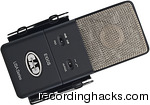 E100S designed by Conneaut Audio Devices or CAD. Very few people in the room had even heard of the brand, let alone seen such a microphone. But when the day was over, several voice actors ended up ordering one. By the end of this review you’ll know why.
E100S designed by Conneaut Audio Devices or CAD. Very few people in the room had even heard of the brand, let alone seen such a microphone. But when the day was over, several voice actors ended up ordering one. By the end of this review you’ll know why.
Its reputation had preceded itself. Prior to the shootout, this rectangular shaped CAD had beaten out the venerable Neumann U87 — regarded by many to be the ultimate voice-over microphone — in a blind test. Not bad for a mic you can buy for less than $400! [See current sale prices on the E100S. –Ed.]
Robust and rectangular
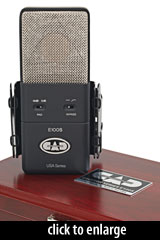 The CAD Equitek E100S as it’s officially called, is a side-address, large-diaphragm FET condenser with a nickel-plated 1 inch capsule, an 80 Hz hi-pass filter and a 10 dB pad. It has a fixed supercardioid polar pattern and the lowest self-noise ratings of pretty much any mic: 3.7 dB (measured with the capsule swapped for a fixed capacitor, known as the “capacitor substitution” method).
The CAD Equitek E100S as it’s officially called, is a side-address, large-diaphragm FET condenser with a nickel-plated 1 inch capsule, an 80 Hz hi-pass filter and a 10 dB pad. It has a fixed supercardioid polar pattern and the lowest self-noise ratings of pretty much any mic: 3.7 dB (measured with the capsule swapped for a fixed capacitor, known as the “capacitor substitution” method).
Coming in at 0.61kg (22oz) it’s not exactly light. Made in the USA, this microphone is built like a tank and it feels solid but smooth thanks to a rubbery coating. It arrives in a nice cherry wood box, already resting in a specially designed ‘stealth’ integral shock mount. You’ll find the XLR output at the back of the microphone.
Strong rubber bands tie the microphone to its snug-fitting shock mount. This mount works well, but it’s a pain in the neck to remove, so I could place the mic in my Rycote InVision™ shockmount. Most people would only take the mic from its mount to replace the rubber bands, so it’s no big deal.
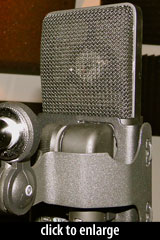 In my recent review of the Gefell M930 Ts, I came up with eight criteria for an ideal voice-over microphone. Now look at the specs for this CAD. Based on my preferences, it comes very close to being perfect — on paper, that is. It is often advertised and reviewed as a versatile, all-purpose mic, so I wondered how well it would work for voice alone.
In my recent review of the Gefell M930 Ts, I came up with eight criteria for an ideal voice-over microphone. Now look at the specs for this CAD. Based on my preferences, it comes very close to being perfect — on paper, that is. It is often advertised and reviewed as a versatile, all-purpose mic, so I wondered how well it would work for voice alone.
To find out, I hooked it up to my new Grace Design m101 preamplifier and started talking. After all, that’s what I do for a living.
[The following samples are 320kbps mono MP3s, created from 44.1/24-bit WAVs.]
Distance: 2 inches
Distance: 5 inches
Distance: 7 inches
Distance: 10 inches
[Following is a longer sample, a poem called Thinking of Holland by Hendrik Marsman, translation by Paul Vincent.]
Thinking of HollandLike a laser
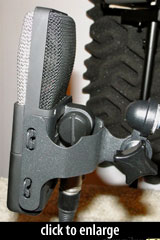 Because of its tight pickup pattern, this is not a microphone for those who like to wobble and wiggle. If close miking is your thing, this CAD is king. Once you have found the sweet spot and you stay there, the mic will hear you loud and clear. It zooms in on your voice like a laser beam, with the accuracy and clarity of a shotgun. Although sonically different, this makes the E100S an alternative to the popular Sennheiser MKH-416, which costs more than twice as much.
Because of its tight pickup pattern, this is not a microphone for those who like to wobble and wiggle. If close miking is your thing, this CAD is king. Once you have found the sweet spot and you stay there, the mic will hear you loud and clear. It zooms in on your voice like a laser beam, with the accuracy and clarity of a shotgun. Although sonically different, this makes the E100S an alternative to the popular Sennheiser MKH-416, which costs more than twice as much.
Soundproofing a studio can set you back thousands of dollars. If that’s out of your range, the next best thing is to find a mic that’s not so sensitive to ambient noise. That’s another reason why this CAD makes an excellent voice-over investment. Off-axis sound spills are kept to a minimum, and yet this mic never sounds one-dimensional. Like a fine Bordeaux, it has a nice open and full body to it.
By engaging the high-pass filter, you can also minimize low frequency rumble from boilers, pumps, planes, trains and trucks. In other words, under less than ideal recording situations, the E100S can save the day.
Sometimes, outside noise is not the problem. Every microphone produces electrical noise, known as equivalent or intrinsic noise. It can be utterly annoying. As a narrator, I don’t want my softer reads to drown in microphone hiss. Of course noise reduction software can come to the rescue, but with this CAD you’re not going to need it. This is hands-down the quietest mic I have ever laid ears on.
Most supercardioids suffer from a more pronounced proximity effect, and with a wide open grille, this mic is no exception. But with a pop filter in place, this was easily remedied.
Conclusion
Like most reviewers, I do my very best to find fault with the products I’m evaluating. In that respect, this CAD gave me a hard time. There is one thing I struggle to understand, though.
In my opinion, the E100S has all the characteristics to become a voice-over’s secret weapon. Why then, is this microphone a virtual unknown in my line of work? Why do colleagues drool over Sennheisers and Neumanns, calling them “the industry standard,” while ignoring the silent quality of CAD craftsmanship from Ohio?
After reading every review ever written and testing it for months, it finally dawned upon me. The CAD E100S has one thing that’s both a strength and a weakness: this microphone is an everyman’s friend.
It can handle sounds as loud as the engine of an airplane and as soft as a woman’s whisper. It loves strings just as much as percussion. Whether it’s used to record the subtleties of Baroque music or the unrelenting power of Punk Rock, this uncompromising CAD can capture it all.
In terms of marketing, the more universal the product, the harder it is to come up with a unique selling proposition. Not everyone looking for a voice-over mic will find the label “all-purpose microphone” very appealing. Secondly, because this E100S is relatively affordable, it’s easy to equate low price with low quality. Perhaps my colleagues would take this mic more seriously if CAD would double the price.
Before that happens, I recommend you seriously consider this amazing American microphone.
After testing many makes and models, one of Holland’s most respected and experienced voice artists summarized it perfectly:
“The E100S is incredibly versatile. If I could only keep one mic in my locker, this one would be at the top of my list. I would gladly part with microphones costing more than eight thousand Euros in order to keep the CAD.”
matthew mcglynn
Huge thanks to Paul and the Dutch VO community for creating this wonderful review!
The CAD E100S in question was provided for evaluation purposes, and although we’d normally send it back, I’m keeping it. CAD folks: send me an invoice!
Voice actors might be interested in hearing character voice superstar Corey Burton record 4 classic character voices through 26 ribbon microphones in our VO Ribbon Mic Shootout.
Posted in Microphones, Reviews, voiceover | 37 Comments »
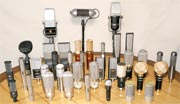


Rick Lance
April 16th, 2012 at 7:19 am
Hum… as you say, I’ve barely heard of this mic. I might have to look into this, being the mic freak that I am. Interesting that you said it tends to roll off low frequency rumble. That I’d have to hear. Most hi-pass filters suck the rich tones from my voice an EQing to make up the difference isn’t the same. If CAD has found a way to NOT do that, I’d have to buy one. Maybe my local music store will have one I can borrow.
Enjoyed your analysis, Paul. You’ve pointed out the marketing issues with this mic pretty well too. That sure sounds plausible to me.
Paul Strikwerda
April 16th, 2012 at 9:47 am
Thank you, Rick. People with a well-isolated recording studio probably won’t have to use the high pass filter as a solution to deal with low-frequency rumble. Under less than ideal circumstances it can make a big difference.
I hope you find an E100S you can borrow. Can’t wait to hear what you sound like using this mic!
Paul
April 16th, 2012 at 9:50 pm
I like its sound. Problem with the price though…only a few places stock it that low. Some sites bump it up to 700.00! Worth it at that price but yeesh.
Tim
April 17th, 2012 at 7:34 am
These guys have been around for a while- I came across them gigging with one sound company about 10 years back, and we kept this mic in reserve for some more unusual sources. Vibraphones, saxophones, brass instruments, washboards, and it always sounded good on the sources.
Never found anyone else who used these. Glad to see it’s not completely forgotten.
matthew mcglynn
April 17th, 2012 at 9:49 am
@Tim, not sure if you’re referring to CAD being around for a while (true) or the E100S being around for a while (not true). There were older “E100” and “E100 v2” models, but the E100S is a much newer product.
Steve Faul
April 17th, 2012 at 12:57 pm
Greetings from Ohio. I’ve seen a row of E100S mics over the string section of the symphony orchestra, so there’s no doubt of this mic’s versatility. Sounds like a voice artist can work the proximity effect quite well, yet get a clear “cut through the mix” sound on high energy stuff. I would be interested in comparing the HP filter to the one in my pre. In the photos I’ve seen it looks like the mic stand connector might limit your options on boom placement. I think CAD isn’t as well distributed as they should be; some retailers don’t stock them at all. That may be keeping CAD in the shadow of other brands.
Rick Winking
April 18th, 2012 at 12:21 pm
Not sure if it is the exact same mic, but I have a pair of the old e100s. I have a bunch of classic mics for acoustic guitar, but the e100s are the best sounding ones I have, bar none. If the e100s is an improvement, I will have to own a pair tomorrow!
Jacob Ekström
April 27th, 2012 at 10:40 am
CAD mics are highly underrated, due to poor marketing.
I have a “vintage” E-300 (mk1) from around 1998 (this one: http://recordinghacks.com/microphones/CAD/Equitek-E300 ).
David Beneke
May 7th, 2012 at 10:26 am
I have been a huge fan of CAD mics for a while. The value and quality in my opinion can not be beat! I have an e300-2 (now the e300-s) and an M179. I have also auditioned the the e100s, all really superb and very low noise. I chose the e300 over the e100 because I wanted a wider cardioid pattern, tonally the mics are about the same, the e100 is quieter however, the e300 more versatile, so it was a trade off. Thanks for bringing more attention to the CAD brand!
Paul Strikwerda
May 7th, 2012 at 1:24 pm
You’re very welcome, David. It’s so easy to look to Germany when it comes to quality microphones, but CAD proves that we don’t have to.
Scott S.
May 9th, 2012 at 9:54 am
Great review, Paul! I also have the E100S which I use for my voice acting hobby and it is indeed an often overlooked VO microphone. How do you feel it stacks up against your Gefell?
Paul Strikwerda
May 9th, 2012 at 12:01 pm
Had I not won the Gefell, I would have bought the CAD E100S.
Overall, the Gefell has a really smooth sound. The CAD can be a bit in-your-face. People who do a lot of promo work might want that in-your-face sound.
Because the pickup pattern is not as tight, the Gefell is more forgiving when I move around. Especially when I have to do pick-ups, I don’t need to be in the exact same spot to get they same audio.
Price-wise the CAD offers excellent value for money.
William Hutch
May 13th, 2012 at 3:19 pm
The problem with Cad is there non-existent customer service. They haven’t answered a single email regarding product inquiry…trouble with a purchase good luck to you.
Glenn Roop
May 14th, 2012 at 9:20 am
Greeting ! Hey William sorry to hear you had a hard time getting to us. We are growing at the speed of sound now days and understand that it can be hard to reach us. I can assure you that we deeply care about your satisfaction and are here to help. Please feel free to contact me at Groop – at – Cadaudio – dot – com
As a side note: I really appreciate all the kind comments about the E100S. We are really proud to engineer and build a product of this caliber… Built in the USA by a company that is owned in the USA.
I recently moved over to CAD Audio from another major mic company and I can tell you with confidence… CAD Audio products are high value and one of the best kept secrets on the market. Lets see if we can spread the word.
Thanks – I look forward to speaking with you !
Glenn
Ryan
May 17th, 2012 at 11:08 am
I must have one of these.
My lead singer LOVES my GXL 3000. He’s used Nuemans, Geffels, etc, etc, and the GXL is by far his favorite to date. I’m extremely happy with the CAD products I’ve used so far.
Thanks for bringing the e100s to my attention!
Cheers
Paul Strikwerda
May 17th, 2012 at 11:34 am
You’re very welcome, Ryan. CAD is awesome!
Pierre-Alexandre Sicart
July 3rd, 2012 at 11:33 am
@Rick: The E100 and E100S are different microphones. The S here isn’t a mark of the plural. Google also confuses both mics for this reason. Not a smart move, marketing-wise.
@Paul: Thank you for the review. However, as in the one you made of the M930Ts, I can only regret the absence of an actual shootout between the E100S and other mics. It’s hard to judge a mic in itself, since we don’t know your voice in real life (at least, I don’t).
@Paul: “They threw about thirty mics into the mix, from shotguns to tube condensers. Among the mics they tried were the Brauner Phanthera, an Audio Technica AT4033, the Neumann M147, TLM103 and U87, the Senhnheiser MKH-416, a Røde NTG3, a Telefunken U47 and an Electro-Voice RE27.” => Now THAT’s what I wish I could listen to!
@Paul: “Prior to the shootout, this rectangular shaped CAD had beaten out the venerable Neumann U87 — regarded by many to be the ultimate voice-over microphone — in a blind test.” => That’s a little vague. What were the circumstances?
@Paul: Thank you for comparing the M930Ts and E100S, two microphones on my Lust List.
I’ve been interested in the E100S for some time, actually. Last year, at my request, Joel Patterson was kind enough to record a short narration. The original link is dead, but I’ll upload the file on my server. Here:
http://www.sicart.info/friends/CAD_E100s.mp3
David Beneke
October 2nd, 2012 at 12:59 pm
Well, I purchased the E100S, and I am really blown away. I’ve been using it to record an audio book, where you really need a very low noise mic, and this baby does the trick, in spades! I have never heard a quieter mic. The show room demo, against a TLM 103, really sold me, the Neumann sounded as if it had scooped highs, whereas the E100S sounded more like reality, only better.
I don’t use the high pass filter, I find I don’t need it, could be the tight pattern of the E100S is less susceptible to rumble. I really don’t think it makes my voice sound “in your face” like a Sennhieser MKH-416, which really colors my voice, in an unflattering way. The E100S has just the right touch of “mellow smoothness” (to quote Ralph in “A Christmas Story”, hey it’s the only way I can describe it…..
Paul Strikwerda
October 2nd, 2012 at 1:27 pm
That’s fantastic, David. I’m so glad to hear that you’ve also discovered this relatively unknown voice-over microphone. I love the expression “mellow smoothness”!
Stewart Strauss
October 6th, 2012 at 9:13 am
Thanks for all the info and insight. I’m comparing mics right now and the CAD E100, E100S and E300S, are at the top of my list. I’m also considering a Heil PR40 and a CharterOak Acoustics S700. My primary purpose will be voiceover, but I want to be able to record my vocals and Fender guitar cabinets, as well. I’m in a fairly noisy environment, and have a fairly bass heavy voice. When I do pickups, using a Sennheiser 416, I’m having a hard time matching levels, probably due to proximity effect. I like the forgiveness of a wider pattern, but don’t want to limit my choices. I’ll be running which ever mic I choose through an Apogee Duet 2, into a MacBook Pro. Thanks for your input!
matthew mcglynn
October 6th, 2012 at 9:23 am
@Stewart, any of these mics could work well, but all of them will work better if you can invest in a better acoustic environment. Condenser mics, even ones with narrow pickup patterns, will “hear” all that ambient noise. If you make your room sound better, whatever mic you pick will deliver better results.
Deep voices tend not to benefit from proximity effect, which means you’ll have a larger working distance than someone with a thinner voice. This again points to the need to work in a quiet, isolated space, so the mic has less opportunity to record all the stuff you don’t want in your track.
Stewart Strauss
October 6th, 2012 at 9:36 am
Thanks for your speedy reply. I’m in a corner house, not far from a freeway. I may be able to isolate the sound a little better than I described. Would you recommend the CAD E100S, because of the low noise ratings or go for one of the others for a little more versatility. I did try out the CharterOak S700 and loved the way it sounded on my voice through good headphones. You could hear every detail and nuance. I think it sounds better on my voice than the Sennheiser 416, but would like to spend less, if possible.
Stewart Strauss
October 6th, 2012 at 9:56 am
I just made the plunge. I went for the CAD E300S, in a pretty cool package on eBay. Thanks for your help and I hope to be able to contribute to the knowledge base, someday soon. This is what I just paid for. http://cgi.ebay.com/ws/eBayISAPI.dll?ViewItem&item=350607344378&ssPageName=ADME:L:OC:US:3160
Stewart Strauss
October 10th, 2012 at 6:46 am
In addition, I ordered the CAD E100S. With all the great reviews, how could I resist.
mateo homan
October 29th, 2012 at 4:35 pm
While training under the phenomenal Jason Tubbs at the Knitting Factory NY, I saw him mic an entire stage with these- Kick, Overheads, Bass, Guitars and Vocals. They sounded incredible.
Susan Johann
November 2nd, 2012 at 8:51 am
Hi, Paul,
I don’t have an ideal recording situation, so this mic is certainly on my radar now. I haven’t seen any reviews by women, and am wondering how it is with women’s voices. Have you heard anything from women using this mic?
Paul Strikwerda
November 2nd, 2012 at 10:35 am
Susan, I’m not a big believer in mics made for men and mics designed for women, although some in the recording community might not agree with me.
How a recorded voice ultimately sounds, depends on many factors: the individual characteristics of the voice, microphone technique, the acoustics in the studio, the preamp that was used and the quality of the studio monitors/headphones used for listening.
It always surprises me how the same microphone somehow sounds differently when the recording takes place in a new setting.
My preference is to record the voice as pure and clean as possible, and to do any sweetening in post-production. That’s where the audio engineer can enrich the thin sound of a female narrator or tone down the booming bass of a male voice actor.
The CAD E100S is an amazingly sensitive and versatile instrument. It will give you a crystal clear and natural recording. I recorded my wife’s voice with this CAD and she sounded like a nightingale!
Richard
February 16th, 2013 at 9:28 pm
Cad mics are just ok, well priced but just ok, i eventually sold mine in favour of Audix mics. End of the Day sound always wins over price! There basic pencil mics are surprisingly good for the price and do the job. Unfortunately the bad side is their non-existent customer service. Its almost as if no-one is at the other end of the email address. but strangely somebody clicks the “read-receipts” go figure??? so i guess you could say, the lights are on but nobody’s home lol.
matthew mcglynn
February 17th, 2013 at 11:51 pm
@Richard, I think it is misguided to write off a brand based on a limited experience with one or two of their models. The E100S is arguably the company’s flagship condenser. It is well worth a listen.
Jen Julian
May 25th, 2014 at 9:02 pm
Thanks for the helpful review, Paul, I look forward to testing out this mic. Wondering if you or anyone on the posts can recommend a mic equally as good and budget-friendly as the E100S but lighter and more conducive to a v.o. travel set up?
Thanks!
ken wheeler
September 24th, 2014 at 6:25 pm
thanks for the recommendation on the E100S
bought one, tested it, its AS awesome as you said, so I bought another one!
Eduardo
January 3rd, 2015 at 10:40 pm
Hi. Thanks for the review. This kind of information has always helped me a lot.
Hope someone is still looking at this review to answer my doubt. 🙂
I am relatively new in the voice over job (Two years). Indeed, it is still a hobby that I use to do some charity work recording short texts, histories, etc.
Anyway I got addicted to that and litle by litle I want to upgrade my equipment and planing to go deeper on this job.
My current set up is a AKG Perception 220, UA Twiin Finity 710 and a MAudio Fast Track.
The result is not so bad and I am aware that is not just the equipment that makes the result. A good interpretation is key, but I insist that the result doesn’t sound as professional as I expect.
I am not worried with the Pre, that I know it is great, but I am thinking on improving the mic or the interface.
Doing some research I am convinced that the replacing the P200 by the e100s would give me the greatest improvment on quality.
As professionals, what would you recommentd? I afraid to invest in the mic, but the interface become the botleneck of my chain.
PS. I am from Brazil, so sorry by the English. I am going to USA in two weeks, so it will be my chance to do this upgrade. Here we don’t have so much stores with plenty of mics to test around or buy and return if it doesn’t work for me, so I have one shot only.
Thanks in advance.
Tim Bick
July 12th, 2018 at 7:28 am
Now that this review is a few years old, interested to know people’s experience with longer term reliability as there has been talk of breakdown issues with this mic.
matthew mcglynn
July 14th, 2018 at 8:11 pm
@Tim, I have not heard of any E100S reliability issues.
Scott
September 19th, 2018 at 10:05 am
@Tim: I bought a used E100S back when this review came out and haven’t had any problems. Very impressed with this mic.
Michael Reid
May 17th, 2019 at 2:48 pm
This is my go-to mic. What a great crystal clear sound that really brings out the clarity of the top end without being harsh at all. I love it.
Mikko Kristjan
September 22nd, 2023 at 9:16 pm
Excellent review that I stumbled upon years ago. Going back here for posterity sake. I have had the CAD E100S for 6? or 7 years now. It is an excellent microphone and has a very forward and present sound. At times it can be a bit thin in the low mids or bass, but in VO we are often cutting that anyways to push the vocal forward so….
A lot of people that have heard this mic shot-out with different microphones on my voice (Schoeps CMIT5U, Earthworks SV33, Earthworks Ethos & Icon Pro, AT5040, AT4040, and AKG C414) have preferred the forwardness / presence of the E100S. Others have said it’s too forward and makes their ears “tingle”.
As always I urge people to have atleast two differing mic signatures in their VO locker. One with lots of forwardness like the CAD, MKH416, TLM103 etc… and something much softer sounding like the Earthworks Ethos, SV33, TLM107 / TLM 193. And in the end if you can only get one microphone maybe something in the middle of forwardness isn’t such a bad idea like the C414 or the Gefell M930ts that Paul has also reviewed.
In fact I have been lusting after the M930ts for some years but I finally got one on the way so I’ll be able to compare it directly myself with the CAD on my voice. Should be interesting. I’m basing my opinion on it being middle forwardness just based off Paul’s recordings of both the CAD and the Gefell here in his reviews. Though maybe my opinion will change on my own voice? Who knows?